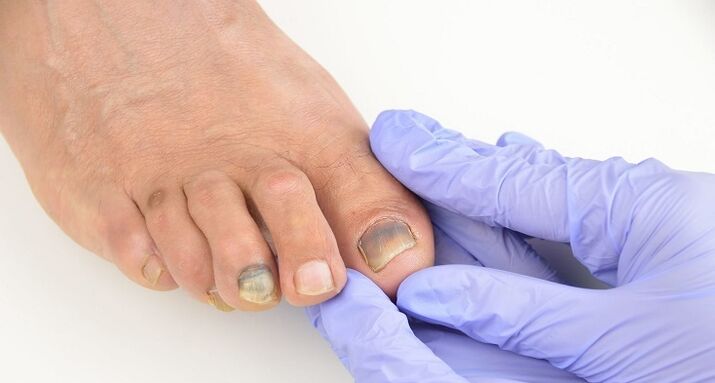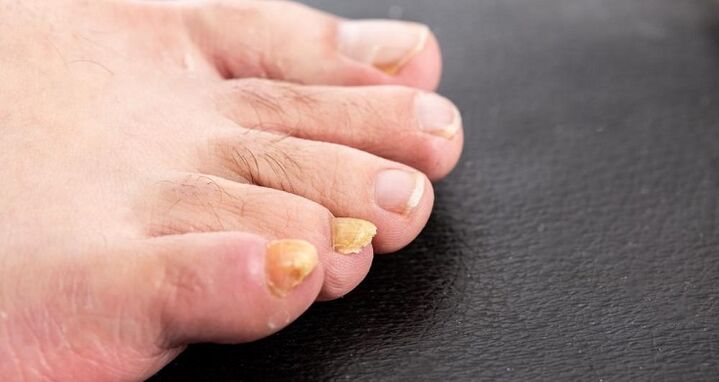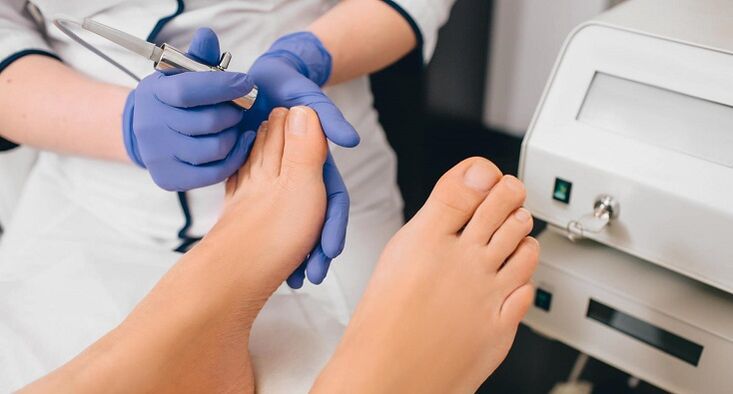Nail fungus is a disease caused by several groups of pathogens. To destroy it, you will need to make a diagnosis to identify all the features of the disease. What are the causes of its occurrence? There are many reasons for the appearance of a fungal infection, the prerequisites for its appearance.

genetic causes of the disease
Fungal spores can be found on many surfaces for years. A person often encounters pathogenic microorganisms, but infection does not always occur. For nail fungus to appear, there must be accommodation factors. The infection must be able to develop. Scientists have done a lot of research on the mechanism of disease onset.
It has been found that one of the factors for the emergence of a fungal infection is genetic predisposition. According to the survey, ringworm occurs more often in people whose relatives have a similar condition. Disease progression affects the genetic level.
Interesting cases of infection in coexistence. With close contact, it is easier to get ringworm. However, it usually runs in one family but does not affect the other. And the disease usually appears in the person who has the genes most similar to the person who initially developed ringworm. According to all these data, the proximity of contact is less important for the infection than the proximity of genetic ties.
ringworm symptoms
Nail fungus manifests itself in different ways at different stages. Ringworm infection usually starts in the interdigital spaces. Right now, there is:
- The appearance of blisters;
- Redness of the skin;
- Itch.
If treatment is not carried out at this stage, the disease begins to affect the nails. In this case, the following signals are detected:
It is best to carry out treatment at this stage as this will reduce the cost of therapy. To destroy microorganisms, external preparations are sufficient: ointments, varnishes. If you don't act, the nail fungus will progress. This is expressed through the following symptoms:
- Thinning or thickening of the nail;
- Nail blade exfoliation;
- Departure from the nail bed;
- The plaque acquires an abnormal color: it becomes white, yellow or black;
- In the later stages, the nail literally falls apart, collapses and an unpleasant odor can occur.
Ringworm exerts its pathological activity not only on the toenails. Inflammatory processes occupy the entire foot.
She starts to blush, takes off. The patient experiences itching, which intensifies during periods of exacerbation. The presence of characteristic signs makes it possible to determine the disease on initial examination.

Types of Fungal Infections
Nail fungus is divided into types depending on the group of microorganisms it is caused by. There are three main groups:
Treatment is carried out depending on the group of microorganisms, as different pathogenic microbes react differently to drugs. Sometimes, when diagnosed, three types of fungi are detected. In that case, complex therapy will be needed.
Fungus Forms
There are several stages of the disease, which differ in the type of lesions:
The treatment regimen prescribed depends on the stage as well as the type of microorganisms. In the early stages, external agents proved effective. In later stages, the therapy regimen is usually a combination of topical and oral medications.
Where can you get a fungus?
Nail fungus is usually spread from person to person. Microorganism spores can remain on surfaces. When you touch them, the fungus stays on the feet and starts to develop. You can get ringworm in the following places:
- Public institutions: saunas, swimming pools, sports club showers. This is the most likely way to get the fungus, as it multiplies more actively in warm, humid environments. To protect yourself, it is necessary, before going to the institution, to undergo preventive foot treatment with medication. You must have your own slippers with you;
- If ringworm occurs in a home, a likely pathway for the onset of the disease in other family members is to shower. The fungus spores remain on its walls, which causes ringworm. For protection, it is necessary to treat surfaces with disinfectants after each trip to the bathroom;
- Sometimes the reason is a manicure or pedicure performed with instruments that have not been disinfected after the last use. It refers to procedures performed in beauty salons;
- Disputes can be lurking in the store, as they are often tried by different people. For protection, you can measure shoes only at the toe;
- A less likely source of infection is public beaches, as nail fungus does not survive well in salty sand.
To prevent illnesses, the importance of personal slippers and the use of prophylactic means should not be forgotten.

Possible complications with prolonged treatment
For ringworm, the rate of development and spread is characteristic. If you delay treatment, the symptoms of the disease will become more and more pronounced. At first, the person is concerned about the aesthetic factor, as thickening, white spots appear on the toenails. But if you don't fight the problem, more serious consequences will follow - pain during movement, itching and burning. Let's consider the most likely consequences of prolonged treatment:
- Other infections are likely as the body weakens;
- Exacerbation of diabetes mellitus. The occurrence, in the context of an infectious process, gangrene or bone tissue infection. All of this can lead to the need for limb amputation;
- If nail fungus is not treated for a long time, the body may react to it with hypersensitivity and allergic reactions. In this context, allergic dermatitis, skin diseases, bronchial asthma are aggravated;
- The extreme stage of ringworm is damage to Organs internal organs. The infection starts to spread throughout the body. This could be fatal.
Another important consequence of not starting therapy on time is the significant financial costs. In the later stages, the disease is not only more difficult to treat, but also more expensive. We'll have to spend money on local procedures, pills. Really effective remedies are more expensive. In some cases, even surgery may be prescribed.
Preventive measures
Nail fungus can be avoided, which is the aim of preventive measures. They allow you to prevent the entry of a pathogenic microorganism and its spread. Prevention is quite simple and consists of following the following tips:
- Elimination of tight shoes, incorrectly selected last. All this leads to the appearance of calluses and other deformities where the infection enters;
- Avoid wearing synthetic socks and tights as your feet will sweat. Sweat and a moist environment are the best conditions for fungus growth;
- It is necessary to observe personal hygiene, wear slippers in closed public places, carry out preliminary treatment of the feet with prophylactic agents;
- After each foot washing, the interdigital areas are completely dried;
- Socks and socks should be changed every day;
- You cannot wear someone else's shoes;
- The house must be kept clean, for which periodic disinfection is performed.
Prevention has two goals - to stop the infection from entering and to stop its development if spores can enter. To achieve the second goal, you'll need to take care of your immune system: playing sports, eating right.
treatment methods
Nail fungus usually takes a long time to heal. The duration of therapy, regardless of the cause of the disease, will be from 6 months to one year. The advantage is that most medications are able to quickly control symptoms. However, despite the disappearance of symptoms, it is necessary to continue therapy until the microorganisms are completely destroyed.
For treatment in the early stages, external medications are used. These include:
In later stages, oral medications are added to external medications:
- Pills;
- antibiotics
Varnishes are especially popular. They have two effects at the same time: they destroy existing microorganisms and create a film that prevents new infections from entering. The tool is able to penetrate deep into the nail. It is colorless and odorless and therefore can be used by men. It is recommended to remove the nail plate before use to ensure deeper penetration.

Ointments and gels are gentle. They are easy to use. Quickly relieve symptoms. With the help of medication, you can treat not only your nails but also the skin around them. The downside is that the product can quickly wear down the skin. To avoid this, compresses can be made: a cotton swab is placed over the ointment layer, fixed with a bandage.
Pills are prescribed in severe cases. This remedy has a strong effect, is toxic and has contraindications. For this reason, therapy is performed under the supervision of a physician.
If the case is completely neglected, surgical intervention comes to the rescue. During the operation, the affected nail is removed. Its removal can be performed without surgery. For this, special means are used. The last option is painless.
Nail fungus is an extremely common problem. Its insidiousness lies in the fact that, in the early stages, signs of illness are negligible. The patient can constantly postpone the treatment as he does not feel discomfort. All of this leads to the problem being neglected. To solve it, you will need a lot of resources and remedies. Ringworm spreads quickly, causing pain, plaque detachment, unpleasant odors, and nail changes.















